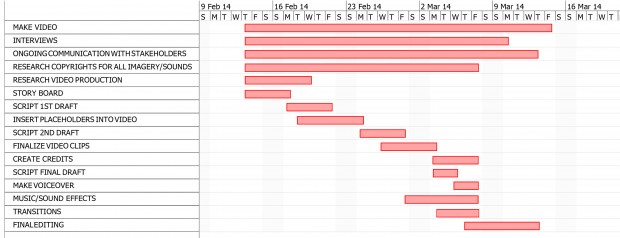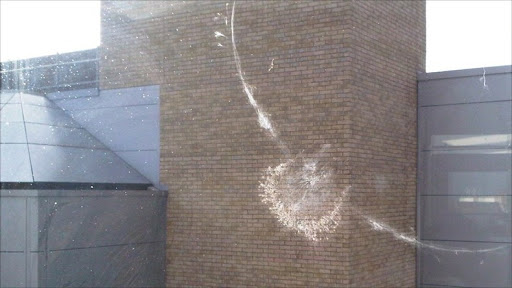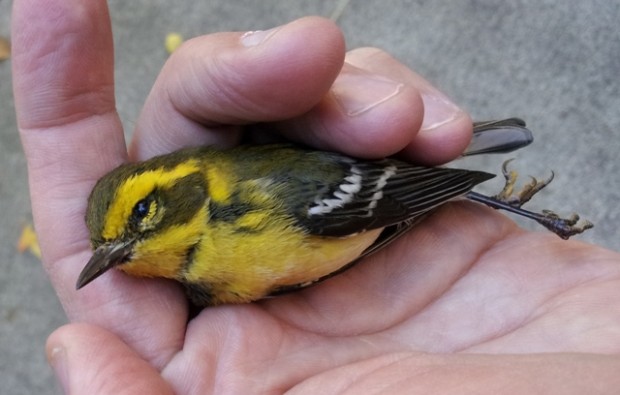Networked Urbanism
design thinking initiatives for a better urban life
apps awareness bahrain bike climate culture Death design digital donations economy education energy extreme Extreme climate funerals georeference GSD Harvard interaction Krystelle mapping market middle east mobility Network networkedurbanism nurra nurraempathy placemaking Public public space resources Responsivedesign social social market Space time time management ucjc visitor void waste water Ziyi
Posts by Karina Adams
I hope early summer is finding you all well. I am on my short break between Spring and Summer term, so I thought I’d give you an update on the Bird’s Striking Building project.
Since March, I have been working with the City of Portland’s Bureau of Sustainability who had created the Bird Friendly Design Guide. They are currently creating a policy that will require bird-friendly design in any new or remodeled city/government projects that are in high-risk zones for bird strikes. They used the video as part of the process of creating their legislation (and were very thankful and complementary!) and they have also had me help them review the actual written legislation/code.
The American Bird Conservancy has also contacted us and wants to use our video for the lobbying they do in Washington DC. Since the video was Portland based, we are talking about altering it for a general audience. Currently, Liz and I are in talks with their marketing coordinator about this. They may end up hiring a professional crew – IE – they have a real budget for actors – their last video had Richard Chamberlain as the narrator. Even if that happens, Liz and I will be involved and they will credit both of us (and PSU).
Recently, I’ve been talking with Portland State University’s Sustainability Office as they are now internally discussing the issue. They are considering working on the windows at the Rec Center and the University President’s office. The Rec Center is the location that Liz and I tried to film the bird ghost but were run off because we couldn’t get permission to film in time.
The Portland Audubon has posted our video at http://audubonportland.org/issues/metro/bsafe/birdsafe
Also, Ornilux, the “spider web” glass manufacturer has posted the video on their website http://www.ornilux.com/bird-
Well, I’m now going to be spending the summer deciding on my thesis topic for this next year. The bird’s are definitely on my mind, but I am also considering other city-animal habitat interactions. My contacts at the Audubon and the City of Portland’s Bureau of Sustainability will be people I will get in touch with to discuss thesis ideas. The Networked Urbanism project has given me the opportunity and contacts that will take me forward in my career.
Thank you! ;-)
Karina
4pm PDX Time
The following is the final video from my term project called “Birds Striking Building Windows”
The whole experience at the final review was quite nice. I enjoyed being able to finally show the video that Liz Cosko and I had been working so hard on.
At the bottom of this post, you will find a written description of the process of this term’s project.
Here is the short video of my experiences of learning about Networked Urbanism. (more…)
02/25/2014 6:00pm PDX Time (NOTE TO WEBMASTER: I can’t get the ordered or un-ordered list to work)
Yesterday, I presented my first pass at the Bird Strike video – what I would call a “story board” video. It is a conglomeration of the videos and still images I have at this point – a mixture of those that will be used, some that are just holding a position in the video “space”, and some that are waiting for higher resolution replacements. There is a bit a information that did not make it into the video that should be noted: there will be something about the Portland initiatives on bird-friendly building design and a bit more about the solutions for both existing and new buildings.
Most of the feedback I got yesterday was encouraging and a few of the comments I received were: 1) spend less time on why we should care about birds – we already know these things, including getting rid of the sequence on birds/wildlife/nature, bird-watching, and man wanting to fly; 2) there’s great tension at the beginning and end, but the video needs something else in the middle; 3) figure out a way to visualize the information on the graphs without using a graph…; 4) in the Solution section of the video, it might be helpful to group solutions for new buildings separately from solutions for existing buildings
Today, I finally got to meet Liz Cosko, the documentary film student who I mentioned in the last blog entry. As mentioned, she is a Post-Bach student who also has a Masters in Biology. She is in Steve Amen’s documentary class and will be submitting the film for her final project as well (FYI – Steve Amen is the producer of OPB’s Oregon Field Guide). Our challenge will be to produce a video so that both class requirements can be fulfilled – she is supposed to have a 10 minute video, while I’m hearing 5-7 minutes from my end…oh, well, just like a real client. ;-)
Today, we went to the Audubon to see about getting footage inside the care center – we are awaiting permission. This week Liz and I will be filming as much original footage as possible in and around Portland. Also, we have an interview set up with the local architect who is working on the Fulton Pump Station at Willamette Park.
Here is the video I presented yesterday – enjoy!
February 15, 3:00 pm PDX time
At the end of this week, I am on the road towards the final project on the Bird Strike issue. I will be focusing on a video that tells the story, reasons why we should care, and solutions. I’ve decided to focus on the video because I am working with the City of Portland on getting the video shown at the planning review department’s waiting room. I am focusing on professionalism, copyright issues, and making the video engaging. The last couple of days, I’ve been researching how to make documentaries and videos and have reached out to the film department to see if there is a film student who would be interested in working on the video with me. I have also been reaching out to all my contacts and working on getting copyright permissions. I am now in contact with a post-BAC documentary film student who has a Bachelors and Master in Biology. I’ll be discussing the project later today with her. I’m optimistic that this will be a good fit.
Yesterday we had our mid-term review before Jose headed out for a week. I presented the Story Board for my video to the class and talked about the current state of the project. Even though I have been focusing on making the video for architects, the general consensus is that it should be engaging for a general audience and should be kept in the 7 minute range. One thought to get it at the more professional level is to look into a film grant. Once I have a better understanding of the skill set of the film student, I’ll determine if we need to be looking into the grant. My biggest challenge now is how to distill all the information and create an interesting video. Below is my first pass at the Story Board and timeline.

On Monday, we finally met Jose, yeah! Most of us got the chance to present a little about our proposal and also got the chance to discuss the audio/visual and reading bibliographies.
Below are .pdf’s of my PowerPoint presentation. The first section describes my proposals for the project and the second section is the bibliographies. I ended up splitting it up into two parts because of space limitations on this blog. Also, there is a video clip and several audio portions that you would hear if you were at the actual PowerPoint presentation. So, when you see magenta writing, you would normally have seen or heard something.
Bird Strikes Power Point Part 1
Bird Strikes Power Point Part 2
The small video that you would have seen on Part 1 is:
Because the NPR portion is copyrighted material, I have included links to the full interviews:
A Clear And Present Danger: How Glass Kills Birds
Building For Birds: Architects Aim For Safer Skies
February 4th, around 10pm PDX time.
It’s interesting to think about how I got to where I am in my project. At the beginning of the quarter, I started out in the group that was looking at nature in the city. We were originally looking at the broad idea of what nature is in the urban environment. We made the video “Squirrel in the City” with the idea of exploring the natural (or not natural) aspects of the city through the lens of biophilia or the love of what is alive. As we made the movie, we realized that wildlife is another part of the urban fabric that we sometimes don’t think about.
When it was time to come up with a curated event, I decided to make a visit to the local Audubon Society. There I was fortunate enough to interview one of the board members and a resident owl named Julio. From this serendipidous event, I learned about a major issue that is related to both birds and architecture. There is a serious problem with birds being killed (and injured) when they run into windows. This led me to the research and project(s) I am working on now.
For the last week and a half I have been busily researching and compiling all the information I could find on birds striking windows – the why, the where, how many, and the impacts. I have also gathered information on the current solutions to the problem which includes laws, policies, and the various solutions that are currently available. Much of this research includes in-person and phone interviews with dozens of local and national researchers, policymakers, volunteers, and manufacturers.
The gist of what I have found is this: approximately 1 billion birds (around 7 million in Portland) die every year in the United States from striking windows – that’s 5-10% of the total bird population. 1 in 10 of these birds are hitting residential windows. The majority of the birds that die are songbirds that come through human habitat during their biannual migrations North or South. They cannot see window glass – the reflections in both mirrored and regular glass looks natural – and, thus, they then run into it. The birds are also drawn into the cities at night because of light pollution. The implications of all these birds being killed are great – some of which are the death of endangered or declining species, and the loss of a massive number of birds which would otherwise be pollinating, eating insects, etc. The physical solution is this – create a way for the birds to recognize the glass as an object so they don’t fly into it. There are many ways to do this including, but not limited to, screening in front of windows, fritting or patterning on the windows, using special UV patterned glass (birds can see the UV when we cannot), painting/adding decals to glass, etc. See these mind maps for more information: PROBLEM SOLUTIONS
Although there are several solutions to the problem, there are two major disconnects that are making this problem difficult to solve. At this point in time there is a lack of education/knowledge of the issue among the stakeholders (architects, building owners, homeowners) and effective solutions are either extremely expensive or, when cost effective, can be visually unattractive.
My proposed solution is two-fold. I plan on making both a video and a design for a cost effective, do-it-yourself solution for the bird-strike issue. The reason I’m looking at making a video is that there needs to be a video for the general public that alerts them to the issue and gives them possible solutions. I may, however, examine another video type – a video that is oriented towards the professional (architect) that alerts them to the issue. I’m considering this second option because I had a conversation today with the Portland Bureau of Planning and Sustainability – they indicated that they might be interested in having a video about the bird strike issue that runs on their monitor in the waiting space at the plan review office. In this video, I could possibly get into the synergies of designing bird friendly buildings that go along with energy efficiency, solar shading, and window privacy.
At this time, I am laying out a story board for the public video and am collecting materials to start testing possible small-scale design solutions for the problem.
An example of some of the information I’ve gathered from interviews is below. One of the people I have been talking with is Dave Helzer, an Environmental Specialist and Biologist from the City of Portland Bureau of Environmental Services. He provided me with the images at the bottom of the page…last Fall and Spring he found these two birds – Rufous Hummingbird and Townsend’s Warbler – they are dead – after they had hit the window of the office building in the image. The reflection in the glass of the tree is what they were flying to…
This was a chance experience that I had no idea was going to happen. I decided to go visit the local Audubon Society since our group was considering “nature in the city”. I asked around to see if someone would be willing to talk to me about what the Audubon’s mission. The following video is an edited version of this wonderful encounter.
This was an interview taken by Karina Adams on January 23rd with Candy Plant (Portland Audubon) and Julio the Great Horned Owl.
Karina Adams
It appears that Karina Adams hasn't tweeted anything yet.



